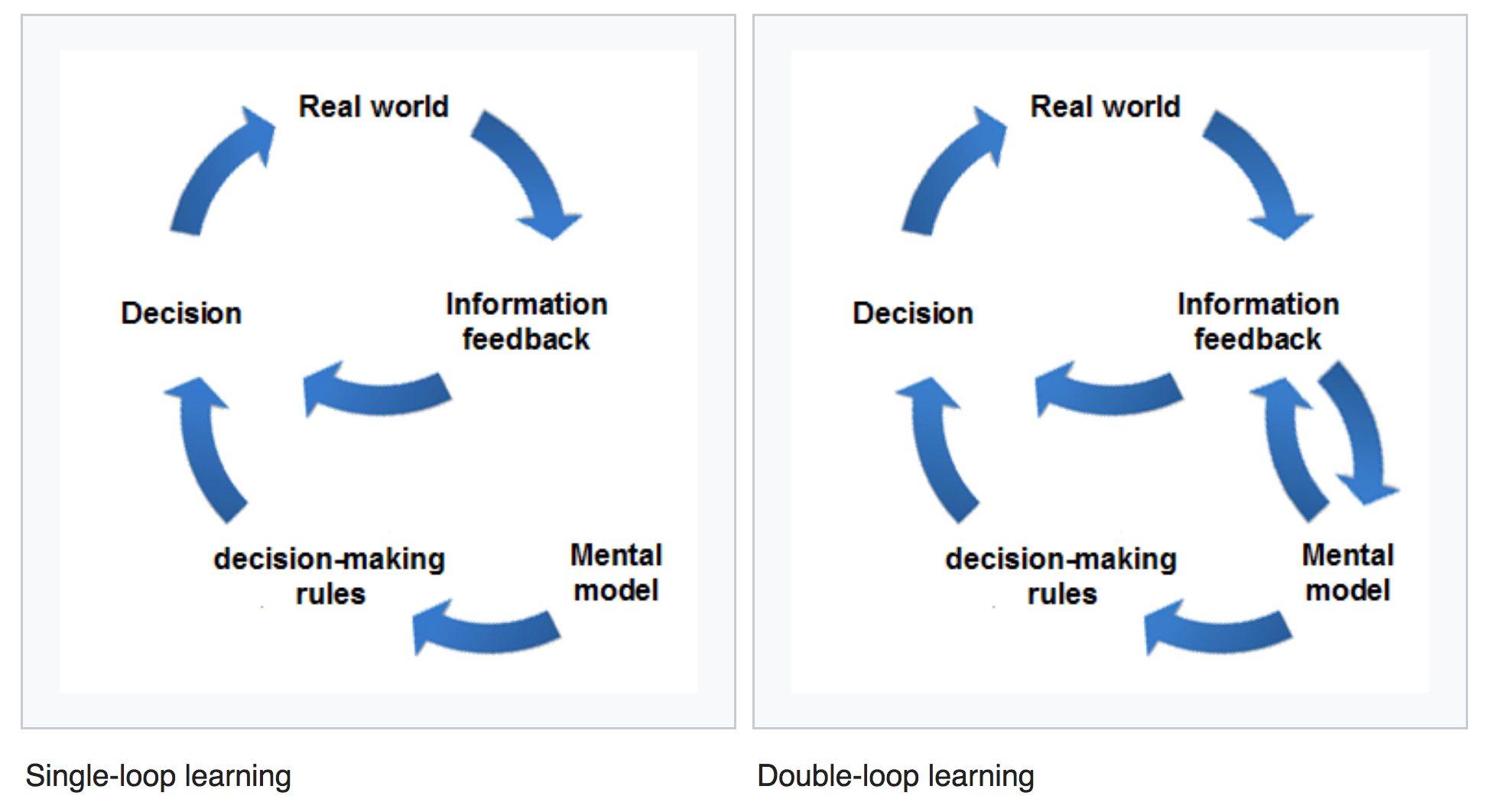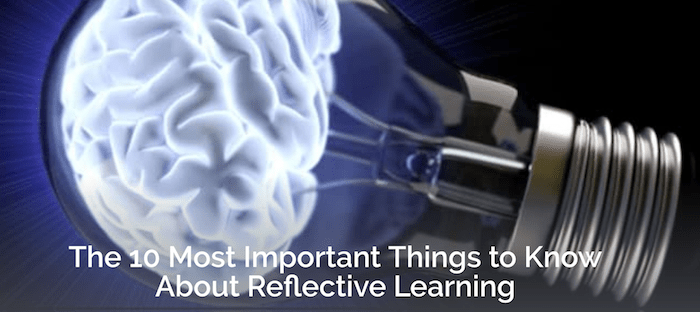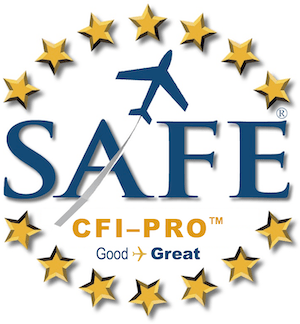Pilots are a “different breed of cat” as you well know. As a personality type we are confident, higher than average in intelligence, tend toward dominance and are almost never wrong about anything! (ask my wife…) “Never wrong” is “sort of” a joke but you know our tribe; pretty self-assured and assertive, with perfectionist tendencies. And though it takes confidence to pilot effectively, pilots also hate to admit to errors (as do most professionals in all fields). This very feature makes pilots and other high-performance professionals remarkably bad at learning. And as experience and hours pile up this problem gets worse not better; success becomes an impediment to further learning. This is a well-known problem in the “C-suite” of business too. Read Teaching Smart People How to Learn by Chris Argyris (a Harvard Business Review Classic) for a great analysis of this problem. Experts and professionals are remarkably good at problem solving but amazingly bad at learning.
Double loop learning is part of action science — the study of how we act in difficult situations. Individuals and organizations need to learn if they want to succeed (or even survive). But few of us pay much attention to exactly how we learn and how we can optimize the process.
Even smart, well-educated people can struggle to learn from experience. We all know someone who’s been at the office for 20 years and claims to have 20 years of experience, but they really have one year repeated 20 times.
Finding and trapping errors is only the first basic feedback loop where we analyze, correct and revise our plans or techniques. This “problem-solving” level is characteristically directed outward, largely analytical, and psychologically painless. Creating and following SOPs or regulations is part of this process. Compensating for changing conditions and “re-trimming” our activies back to the desired flow is all part of a normal day.

Real progress and improvement (learning and not just problem-solving) occurs at a higher level and involves tweaking the mental models and preventing the error in the first place. This requires time to reflect critically on our own behavior and failings, solving deeper thinking/scripting problems. Level two or “double loop” learning freely admits to errors and fixes our inner OS that is usually the root cause. Every error should be viewed as a “double loop opportunity” to dig deeper and reflect on our assumptions and test the validity of our hypotheses. Only though “reflective learning” can we access and correct our normally invisible implicit level of learning.

For professionals, inward directed reflection can be initially psychologically painful. Professionals and expert performers are used to being “competent and correct” but “double loop learning” requires we admit, accept and correct personal failings. In addition, this is often only the first step. Accepting instruction, taking wise counsel humbly (and happily) is the key to real and rapid improvement. So we need to soften that pilot wall of confidence a bit and admit to personal failure to achieve growth. Learning happens at the “double loop” reflective level. A sure sign of this is when a good pilot say “thank-you” when an error is pointed out, and in the debrief not only makes a “note to self” to correct the obvious goof going forward but also resolves the deeper assumption/hypothesis that was the root cause.
Highly skilled professionals are frequently very good at single loop learning. After all, they have spent much of their lives acquiring academic credentials, mastering one or a number of intellectual disciplines, and applying those disciplines to solve real-world problems. But ironically, this very fact helps explain why professionals are often so bad at double-loop learning.Put simply, because many professionals are almost always successful at what they do, they rarely experience failure. And because they have rarely failed, they have never learned how to learn from failure. So whenever their single-loop learning strategies go wrong, they become defensive, screen out criticism, and put the “blame” on anyone and everyone but themselves. In short, their ability to learn shuts down precisely at the moment they need it the most.
As humans, evolving over millions of years, we are internally hardwired with all kinds of implicit reactions and biases that serve us amazingly well in survival against primordial threats and historical environmental challenges. Unfortunately, this deep imprinted learning is subconscious and only becomes visible in action. We need to reflect, accept, adapt and rewire these internal systems with double loop learning if we want to function accurately under pressure in each specific aviation environment.
As aviation educators, it is also essential to develop these”double loop” corrective abilities in our clients. Once they are competent and approaching independent flight, it’s necessary (and initially excrutiating) to allow our these pilots the time and opportunity to discover (struggle) and correct their own errors! The #1 beginner CFI mistake is to immediately intervene and correct every mistake and not allow a “learning opportunity” (genius in the right seat). Your pilot will never develp the metacognitive capacity to self-correct and improve ; they will need a CFI forever. Our educational goal should be to create confident, independent, lifetime learners in every pilot.
And as educational professionals, we all need to continually learn and improve. Join us for the CFI-PRO™ workshop on October 2-3, 2019 at AOPA (KFDK) Pursue personal improvement and excellence in your flying (and teaching), we have your back! See you at AOPA-Fly-In TN (get a free Sporty’s FIRC with sign-up) and enjoy 1/3 off Foreflight (member benefit) which more than pays your annual dues. Fly safely (and often!)
 Please “follow” our SAFE blog to receive notification of new articles. Write us a comment if you see a problem or want to contribute an article. We are always seeking more input on aviation improvements and flight safety. There are many highly qualified aviation educators out there! Please Join SAFE and support our mission of generating aviation excellence in teaching and flying. Our amazing member benefits alone make this commitment worthwhile and fun. Lastly, use our FREE SAFE Toolkit App to put pilot endorsements and experience requirements right on your smart phone and facilitate CFI+DPE teamwork. Working together we make safer pilots!
Please “follow” our SAFE blog to receive notification of new articles. Write us a comment if you see a problem or want to contribute an article. We are always seeking more input on aviation improvements and flight safety. There are many highly qualified aviation educators out there! Please Join SAFE and support our mission of generating aviation excellence in teaching and flying. Our amazing member benefits alone make this commitment worthwhile and fun. Lastly, use our FREE SAFE Toolkit App to put pilot endorsements and experience requirements right on your smart phone and facilitate CFI+DPE teamwork. Working together we make safer pilots!
